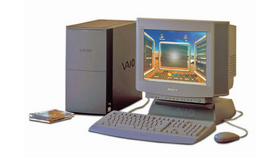PCV-**0: Difference between revisions
More actions
Romanio0089 (talk | contribs) mNo edit summary |
Romanio0089 (talk | contribs) mNo edit summary |
||
| Line 1: | Line 1: | ||
{{Infobox Specs | |||
| name = PCV-**0 | |||
| image = VAIO PCV-90.png | |||
| subtitle = VAIO PCV-90 | |||
| series = PCV-70, PCV-90, ... | |||
| rel = 1996 (US), 1997 (JP) | |||
| cpu = Intel Pentium 166/200MHz | |||
| gpu = ATI Rage 3D (2MB VRAM) | |||
| chipset = Intel 430HX | |||
| memory = 16MB or 32MB EDO RAM, maximum 128MB | |||
| display = desktop | |||
| storage = 2.1 or 2.5GB hard drive | |||
| audio = Yamaha YMF701 (3D SRS Surround Sound) | |||
| os = Microsoft Windows 95 | |||
| weight = 11.57kg (25.5lbs) | |||
| size = ? | |||
| msrp = up to $3000 for top spec PCV-90 | |||
}} | |||
== Overview == | == Overview == | ||
The Sony VAIO PCV-**0 (PCV-70, PCV-90, ...) were the first computers released by Sony under the VAIO line. Unusually for Sony, they were released in 1996 in the US and 1 year later in Japan in 1997, branded as the PCV-T. They were intended as computers designed for multimedia. Sony used the VAIO name for many reasons, one of them was because the VA joined together to symbolise a sine wave and the IO meaning the binary symbol for on and off, and this joined together name was supposed to represent the integration of analog and digital technology. | |||
[[File:Vaio space 2.png|thumb|VAIO Space interface]] | [[File:Vaio space 2.png|thumb|VAIO Space interface]] | ||
The PCV series of desktops featured a unique purple colour, which stood out among the vast amounts of beige towers (keep in mind this was 2 years before the iMac G3) They often came in a bundle with a matching purple CRT monitor, keyboard and mouse. To match the multimedia theme of the computer, they came with a unique desktop replacement interface called VAIO Space, which had "3D" styled graphics and was truly unique compared to other desktop replacement offerings. They came with a fair share of multimedia features, such as a 8X CD-ROM drive standard, and a built in Yamaha YMF701 sound chip. | The PCV series of desktops featured a unique purple colour, which stood out among the vast amounts of beige towers (keep in mind this was 2 years before the iMac G3) They often came in a bundle with a matching purple CRT monitor, keyboard and mouse. To match the multimedia theme of the computer, they came with a unique desktop replacement interface called VAIO Space, which had "3D" styled graphics and was truly unique compared to other desktop replacement offerings. They came with a fair share of multimedia features, such as a 8X CD-ROM drive standard, and a built in Yamaha YMF701 sound chip. | ||
== Daily Usage Today == | == Daily Usage Today == | ||
| Line 42: | Line 42: | ||
|+Presentation Pages | |+Presentation Pages | ||
|- | |- | ||
| | | Does not exist. | ||
|} | |} | ||
Revision as of 17:32, 22 February 2025
Overview
The Sony VAIO PCV-**0 (PCV-70, PCV-90, ...) were the first computers released by Sony under the VAIO line. Unusually for Sony, they were released in 1996 in the US and 1 year later in Japan in 1997, branded as the PCV-T. They were intended as computers designed for multimedia. Sony used the VAIO name for many reasons, one of them was because the VA joined together to symbolise a sine wave and the IO meaning the binary symbol for on and off, and this joined together name was supposed to represent the integration of analog and digital technology.

The PCV series of desktops featured a unique purple colour, which stood out among the vast amounts of beige towers (keep in mind this was 2 years before the iMac G3) They often came in a bundle with a matching purple CRT monitor, keyboard and mouse. To match the multimedia theme of the computer, they came with a unique desktop replacement interface called VAIO Space, which had "3D" styled graphics and was truly unique compared to other desktop replacement offerings. They came with a fair share of multimedia features, such as a 8X CD-ROM drive standard, and a built in Yamaha YMF701 sound chip.
Daily Usage Today
You can use them for some old software designed to run at the time. These days they are mostly used for retro gaming, and due to the expandability you can upgrade them and get a very good experience when gaming. These also came with a very nice sounding Yamaha sound chip, so you will get excellent sound in DOS games.
Resources
If a link is broken, please input the URL in the Wayback Machine.
Manuals and Useful Links
| PCV-70/90 Manual | |
| PCV-120 Manual |
| Does not exist. |
Recovery Discs
These discs are not compatible with SVRP, but we are working on a patcher for older recoveries.
| PCV-70 and 90 Recovery Disks | Internet Archive |
| PCV-70 and 90 Software | Internet Archive |
| Cracked PCV-100 Disks | Internet Archive |
Guides
| HDD to SSD upgrade | YouTube |

